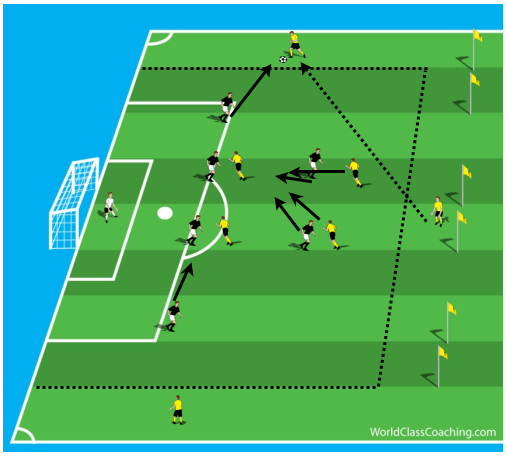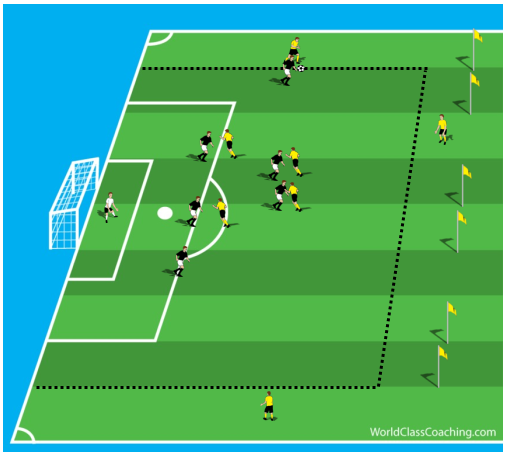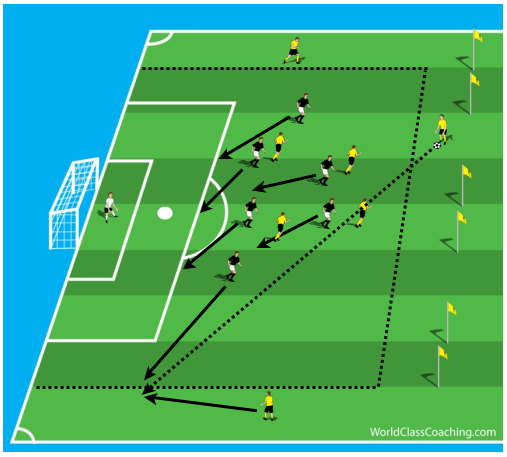By Sean Pearson
Objectives
- To pressure the crosser
- Force the crosser back up the field
- Defensive positioning
The main priority of this practice is to pressure the wide player quickly enough to stop the cross. If the ball cannot travel towards the goal the opposition will not score, simple. You want to force the ball back up the field, you do not want to keep showing the ball down the line as this has the potential to cause a corner which is…a free cross!
Body position is very important in forcing the ball away from your goal, one of the first things you as a coach and your full backs have to figure out on game day is what foot the wide player is. Are the a right footed winger on the right side, so want to go down the line, or are they on the left so want to cut in all the time for either an in swinging cross or shot. This will determine body position and field position. Of course you may get the rare two footed player which is a full back’s nightmare.
First we will look at wide players who like to use out swinging crosses. As the ball is travelling to the winger in the wide zone that side full back aims to meet the winger as the ball arrives. This does not allow the winger to build up any momentum. It is important that the full back realizes their priority is to stop the cross first and not win the ball. If the winger has a bad touch and they can win it, yes win it, but otherwise make the winger slow down.
The full back’s body position should be nearer to the wingers strong foot closing off the line, but not so much that they can come inside. The full back should be at an angle forcing the winger back up the field and not square to the ball. They are successful if the winger passes back to the midfielder in the zone. If the defender does win possession the defense can counter and score in one of the three goals.
As the full back goes out to stop the winger crossing the ball, the CB’s, CM’s get touch tight, sideways on so they can see the player and where the ball is. The opposite full back pinches in, but maintains awareness of the opposite winger. The opposite winger is allowed to come in if a cross does come in.
When the ball gets played back to the midfielder in front of the 3 goals the whole defense moves with the ball in order to restrict the space directly in front of them. The offense can pass the ball to whoever but the defense is purposely tight and compact in the middle so the offense pass out wide so the defense can again work to stop the cross.
To turn the defense around, the midfielder should look to play balls over the top ahead of the wingers, this will force the full backs to make a recovery run to close the space. If the full back is first to the ball they can force the ball out of play via a tackle, shield it or pass to a teammate to work the ball to one of the three goals.
Then flip the wingers so their strong foot is on the inside of the field and they want to keep cutting in. The position the full back should now take up is further in field as the winger will most likely keep the ball on their strong foot so now they will be closer to the ball, even if the winger goes down the line, they will either try to cut back on their strong foot, or into your full back, or try to cross with their week foot, which will most likely go out for a goal kick. You could further switch your full backs so the wingers always want to run into the stronger, more dominant foot.
Coaching Points
- Get to the winger as the ball arrives
- Determine which is their strong foot and position yourself accordingly
- Contain the winger by slowing them down and forcing them to play backwards
By Sean Pearson. Sean is also the author Coaching Team Shape in the 3-3-1, Coaching Team Shape in the 4-2-3-1 and Coaching Team Shape in the 4-3-3






